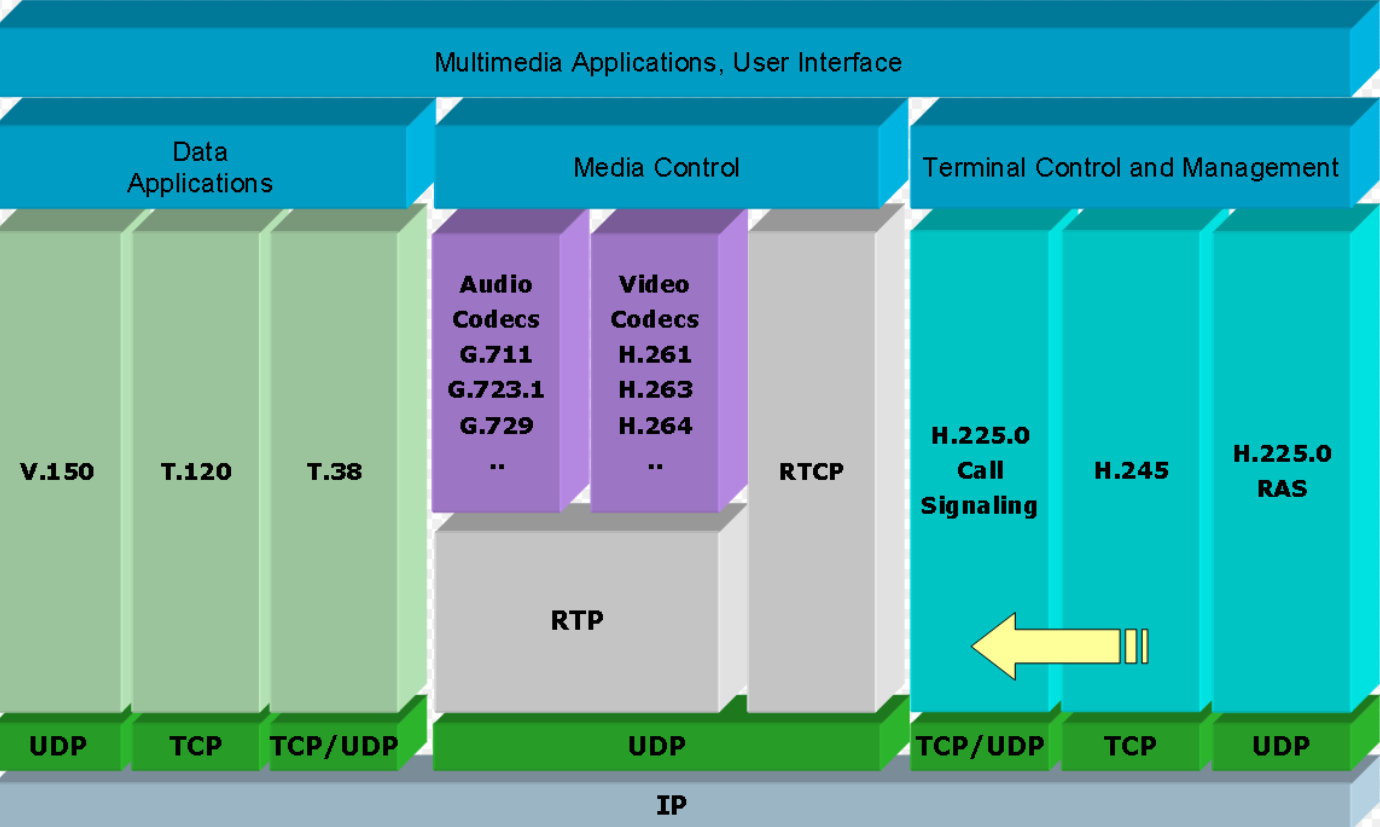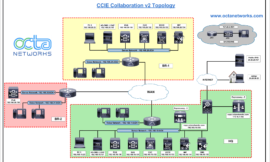H.323 and Media Gateway Control Protocol (MGCP) are two protocol suites that the industry uses to support VoIP. H.323 recommendations are supported by the International Telecommunication Union (ITU-T) and MGCP is supported by the Internet Engineering Task Force (IETF). H.323 and MGCP are not stand-alone protocols. These protocols depend on many other supporting protocols to complete their operations.
H.323 was created by International Telecommunication and Union and Telecommunication Standardization Sector (ITU-T) for simultaneous voice, video and data transmission across ISDN connections. It is being adopted to work in LAN environments.
H.323 is a suite of protocols providing multiple services:
- H.225.0 Call Signaling – Fundamental signaling protocol. Loosely can be termed as SIP counterpart
- H.245 Control protocol – Loosely termed as the functional counterpart of SDP
- RTP & RTCP – Protocols for transferring media, statistics & control information
- H.225.0 – Registration, Admission & Status (RAS) – It provides call signaling in a hierarchical pattern.
Whether to use H.323 or MGCP is a customer-specific decision since they have very similar features. This document discusses the advantages and disadvantages of H.323 and MGCP and what each one supports.
Now we will learn about each of these signaling protocols in detail as under:
H323
H.323 is an ITU umbrella recommendation for multimedia communications over IP-based networks that do not provide a guaranteed quality of service. H.323 covers point-to-point communications and multi point conferences and addresses call control, multimedia management, bandwidth management, and interfaces between LANs and other networks.
The basic components of the H.323 protocol are terminals, gateways, and gatekeepers (which provide call control to H.323 endpoints). Similar to other protocols, H.323 applies to point-to-point or multi point sessions. However, compared to MGCP, H.323 requires more configuration on the gateway since the gateway must maintain the dial plan and route patterns.
This list describes some of the features of H.323:
- H.323 call routing with Cisco Call Manager—With H.323, Cisco Call Manager only sees the router as one gateway. Calls are sent to the gateway but Cisco Call Manager cannot specify which port the call is sent to. Cisco Call Manager does not even know that multiple ports exist on the gateway.
In the reverse direction, an H.323 gateway can decide where to send individual calls. Some calls can go to Cisco Call Manager and other calls can go directly to other H.323 gateways without involving Cisco Call Manager.
- H.323 gatekeeper—A gatekeeper is an H.323 entity on the network that provides services such as address translation and network access control for H.323 terminals, gateways, and multi point control units (MCUs). Gatekeepers also provide other services such as bandwidth management, accounting, and dial plans that you can centralize to provide scalability.
Gatekeepers are logically separated from H.323 endpoints such as terminals and gateways. They are optional in an H.323 network. But if a gatekeeper is present, endpoints must use the services provided.
- H.323 gateway dial-peer configuration for Cisco Call Manager server redundancy – Cisco IOS H.323 gateways can be configured for Cisco Call Manager server redundancy so that if the primary Cisco Call Manager server fails, the secondary Cisco Call Manager server takes over and the IP phones re-home to the secondary server.
- Caller ID—H.323 provides caller ID from Foreign Exchange Office (FXO) and T1 channel associated signaling (CAS) ports
- Fractional PRI support—H.323 supports the use of Fractional PRI.
- Interoperability—H.323 is widely used and interoperates well with applications and devices from multiple vendors.
- Non-Facility Associated Signaling (NFAS) support—Support for NFAS allows the H.323 Gateway to control more ISDN PRI lines with one D channel.
- Integrated access—Data and Voice on the same T1/E1.
- Legacy systems support—More TDM interface types and signaling supported (for example, Analog-DID, E&M, T1 FGD, E1 R2…)

H.323 protocol suite layers.
The H.323 protocol suite is split into three main areas of control as under:
- Registration – admissions, and status (RAS) signaling – provides pre-call control in H.323 gatekeeper-based networks
- Call Controlling Signaling – Use to connect, maintain and disconnect calls between endpoints
- Media Control and Transport – Reliable H.324 channel to carry media control messages.
Advantages and disadvantages of the H.323 protocol

MGCP
With MGCP, Cisco Call Manager knows and controls the state of each port on the gateway. MGCP allows complete control of the dial plan from Cisco Call Manager and gives the Call Manager per-port control of connections to the public switched telephone network (PSTN), legacy PBX, voice mail systems, plain old telephone service (POTS) phones, and so forth. This is implemented with the use of a series of plain-text commands sent over User Datagram Protocol (UDP) port 2427 between the Cisco Call Manager and the gateway. Another concept relevant to the MGCP implementation with Cisco Call Manager is PRI back haul. PRI back haul occurs when Cisco Call Manager takes control of the Q.931 signaling data used on an ISDN PRI.
Note: Cisco CallManager does not support the configuration or use of a fractional PRI when you use it with MGCP. If fractional PRI is necessary, you can use H.323 instead of MGCP.
If you configure the gateway to run MGCP, the gateway needs to register with the Cisco Call Manager. If you configure settings for input/output gain, or echo in the router, and then add the port to Cisco Call Manager as an MGCP gateway, those settings are overwritten by Cisco Call Manager. When MGCP is used, the Cisco Call Manager controls routing and tones and provides supplementary services to the gateway. MGCP provides:
- Call preservation—calls are maintained during fail over and failback
- Redundancy
- Dial plan simplification—no dial-peer configuration is required on the gateway
- Hookflash transfer
- Tone on hold
- MGCP supports encryption of voice traffic.
- MGCP supports Q Interface Signalling Protocol (QSIG) functionality.
In new releases of Cisco IOS, Cisco Call Manager and Cisco IP Phone Firmware MGCP can support new features such as Call Admission Control, Dual-tone Multi frequency (DTMF) relay, and Network Address Translation (NAT).
This list describes these new features:
- MGCP VoIP Call Admission Control—This feature was introduced in Cisco IOS Software Release 12.2(11)T. The MGCP VoIP Call Admission Control feature enables certain Cisco Call Admission Control capabilities on VoIP networks that are managed by MGCP call agents. These capabilities permit the gateway to identify and refuse calls that are susceptible to poor voice quality. Poor voice quality on an MGCP voice network can result from transmission artifacts such as echo, the use of low-quality codecs, network congestion and delay, or from overloaded gateways. You can use echo cancellation and better codec selection to overcome the first two causes. The last two causes are addressed by MGCP VoIP Call Admission Control.
- MGCP-based DTMF Relay—This feature was introduced in Cisco IOS Software Release 12.2(11)T. DTMF relay conforms to RFC 2833 which was developed by the IETF Audio/Video Transport (AVT) working group. Per RFC 2833, DTMF is relayed using Named Telephony Events (NTEs) in Real-Time Transport Protocol (RTP) packets. This feature provides two modes of implementation for each component:
- Gateway-controlled mode
- The call agent (CA)-controlled mode
In gateway-controlled mode, gateways negotiate DTMF transmission by exchanging capability information in Session Description Protocol (SDP) messages. That transmission is transparent to the CA. Gateway-controlled mode allows the use of the DTMF relay feature without upgrading the CA software to support the feature. In CA-controlled mode, CAs use MGCP messaging to instruct gateways to process DTMF traffic.
- MGCP NAT support on Cisco IP phones—NAT is supported on IP phones from release 7.3 and later. When NAT is enabled on the Cisco MGCP IP phone, MGCP messages can traverse NAT/firewall networks. The Session Description Protocol (SDP) message is modified to reflect the NAT parameters so that if NAT is enabled, the SDP message uses nat_address and a Realtime Transport Protocol (RTP) port between the start_media port and the end_media_port range. The UDP port for MGCP messages can be configured using parameter voip_control_port.
- MGCP call routing—With MGCP, Cisco Call Manager individually controls the gateway and each endpoint. If you have multiple ports on the same gateway, Cisco Call Manager can decide which port to send a call to. Each endpoint (port) is treated as a separate gateway in Cisco Call Manager.
In the reverse direction, an MGCP gateway sends all calls to Cisco Call Manager and has no choice in call routing. Cisco Call Manager does all of the routing in both directions.

MGCP signaling
Advantages and disadvantages of MGCP protocol




